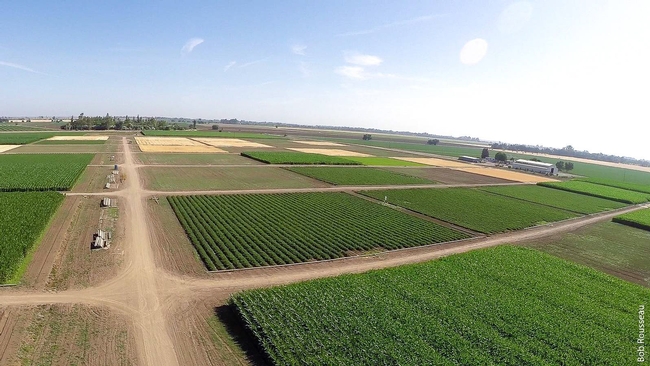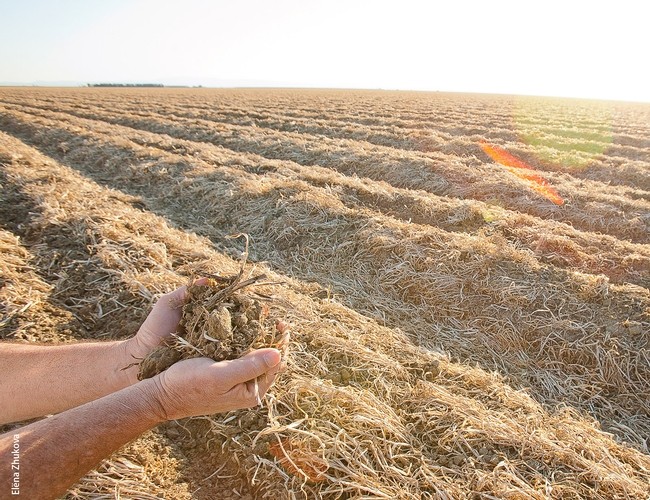California agriculture contributes to and is impacted by climate change
Agriculture in California is on both sides of the climate change challenge. It is a sector that releases significant quantities of climate-warming greenhouse gases into the atmosphere. At the same time, it is vulnerable to the expected effects of climate change, including increased drought and flooding and more intense and longer heat waves.
Three review articles in the current issue of California Agriculture, the research journal of UC Agriculture and Natural Resources, summarize the state of knowledge on three topics at the intersection of climate and agriculture in California: agricultural resilience to climate change (“climate-smart” agriculture); cropland emissions of nitrous oxide, the most important non-livestock source of agricultural emissions; and opportunities for working lands to contribute to meeting state greenhouse gas targets.
The first article, Long-term agricultural experiments inform the development of climate-smart agricultural practices, discusses the research underway to incorporate resiliency in agriculture to extreme and unpredictable weather patterns induced by climate change.
The authors describe the “Century Experiment” at UC Davis. Established in 1992, the Century Experiment is a replicated research project that includes 72 one-acre plots planted to 10 different cropping systems. The plots will be monitored and data collected for a period of 100 years, but Californians won't have to wait that long to see results.
In the first 20 years, for example, testing has found that soil carbon increased significantly more in the organic tomato-corn system than it did in any other crops and management systems. Soil infiltration rates and aggregate stability were also greater in the organic than conventional tomato-corn system.
Soil amendments – such as agricultural and food wastes and winter cover crops – have led to increased soil carbon sequestration, higher infiltration rates and greater aggregate stability in the organic system, compared to conventional systems.
The authors believe maintaining healthy soils is a key to climate-smart agriculture. Properties such as porosity, water retention, drainage capacity, carbon sequestration, organic matter content and biodiversity all help to confer resilience to new pests, diseases and weather extremes brought on by climate change.
The second article, Nitrous oxide emissions from California farmlands: A review, presents the results of 16 California-based studies.
Nitrous oxide emissions are the largest direct source of greenhouse gases from cropland in California and nationally.
The studies reviewed in the paper indicate that the nitrous oxide emissions factor – the fraction of applied nitrogen that ends up being released as nitrous oxide – can vary widely depending on crop, irrigation method, climate and other variables. Accounting for these large differences is important in improving the accuracy of estimates of overall nitrous oxide emissions from farmland, and in designing measures to reduce those emissions.
The final article, Review of research to inform California's climate scoping plan: Agriculture and working lands, covers the range of ways that California's diverse agricultural systems can contribute to meeting the state's commitment to reduce greenhouse gas emissions by 40 percent from 1990 levels by 2030.
Slowing farmland conversion to urban uses and reducing emissions from the intensive livestock sector appear to provide the best opportunities for agriculture-related reductions. About two-thirds of direct agricultural emissions are from livestock production, particularly the dairy sector (the largest sector of the state's agricultural economy by annual revenue).
Because of the dairy sector's comparatively large contribution to agriculture's greenhouse gas emissions, the authors expect it to be a primary target for state climate regulations and incentives for emission reduction. They note, however, that policies should account for the already high levels of resource efficiency at California dairies.
The best opportunities for reductions in emissions from livestock operations center on feed and manure management. A report submitted to the California Air Resources Board says it may be feasible for California to achieve a 50 percent reduction in methane emissions from dairy if supportive practices are taken. Such practices might include:
- Switching from flush water lagoon systems to solid-scrape or dry manure management.
- Covering manure lagoons to capture biogas.
- Installing anaerobic digesters to capture and use methane.
- Use pasture-based dairy management.
The Legislature recently approved using $99 million in funds from the state cap and trade program to support the expansion of manure digesters and other technologies designed to greatly reduce emissions from livestock operations.
The review article also discusses potential for reducing greenhouse gas emissions from agricultural land in California by engaging in farmland and rangeland preservation, improved soil and nutrient management, integrating and diversifying farming systems, employing alternative practices in rangeland management and producing energy with biomass.



